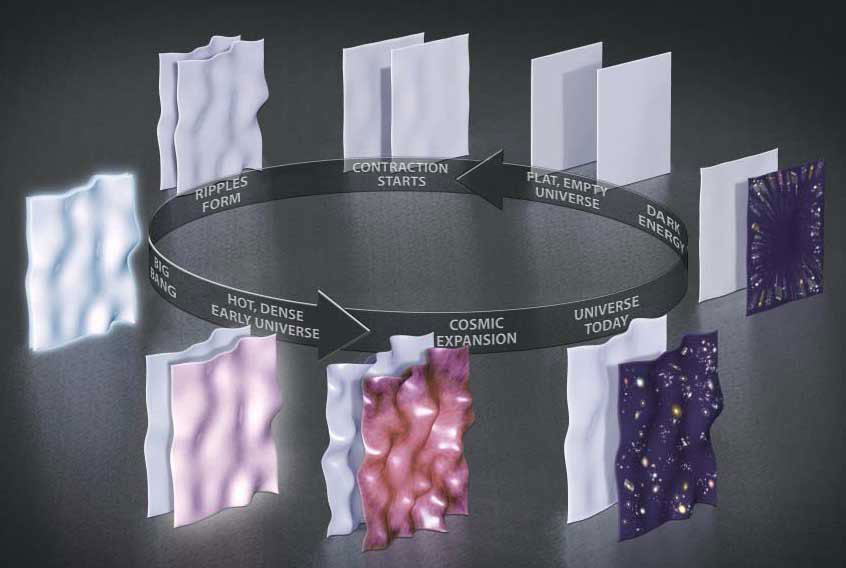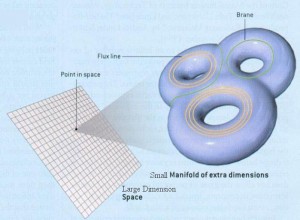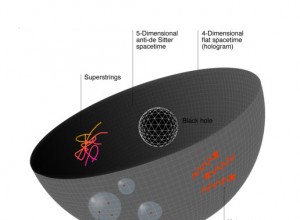One may wonder, What came before the Big Bang? If space-time did not exist then, how could everything appear from nothing? . . . Explaining this initial singularity —where and when it all began—still remains the most intractable problem of modern cosmology, science and philosophy in general. ~ Andrei Linde: I might add – will always remain so, never to be ‘solved’!
An equation means nothing to me unless it expresses a thought of God. S. Ramanujan!
In my last post, I showed that the kappa symmetric algebraic equation:
![]()
has a Sasaki-Einstein solution. It can be seen that any such solution generates the SUSY vacuum for the sparticle spectrum:
![]()
with ![]() being the string variable on the corresponding 2-D world-sheet, and
being the string variable on the corresponding 2-D world-sheet, and ![]() the super-Lagrangian manifold, and solving gives us a exact and complete description of the sparticle fields ‘living’ on:
the super-Lagrangian manifold, and solving gives us a exact and complete description of the sparticle fields ‘living’ on:
![]()
with ![]() being a 5-D Sasaki-Einstein manifold. Let me now, in this context, raise deep philosophical problems, for both,
being a 5-D Sasaki-Einstein manifold. Let me now, in this context, raise deep philosophical problems, for both, ![]() : which is critical for explaining Higgs physics, and for the Big Bang Theory. Note first, that by
: which is critical for explaining Higgs physics, and for the Big Bang Theory. Note first, that by ![]() and the Heisenberg uncertainty principle for time and energy, denoted here by
and the Heisenberg uncertainty principle for time and energy, denoted here by ![]() , the expression in
, the expression in ![]() , namely:
, namely:
![]()
can be diffeomorphically transformed into a derivative funtor of the string variable as a function of time: ![]() , and thus, we get:
, and thus, we get:
![]()
Now, by ![]() , given that the Dp+n brane tension
, given that the Dp+n brane tension ![]() , by unitarity, always has positive-definite energy, ‘time‘ is hence in quantum superposition with respect to energy, thus
, by unitarity, always has positive-definite energy, ‘time‘ is hence in quantum superposition with respect to energy, thus
![]()
will have no solution, entailing that the super-Lagrangian manifold ![]() is degenerate topologically and can neither admit a Ricci tensor nor a Minkowskian metric: hence,
is degenerate topologically and can neither admit a Ricci tensor nor a Minkowskian metric: hence, ![]() cannot be the Kähler vacua that generates the sparticles, and since the existence of the Higgs superpartner is a necessary condition for a complete explanation of the Gibbs-cosmological mass distribution, we have a catastrophe, since that implies the universe has no matter, and that really matters! Moreover, and more severe, is that ‘time‘ as it occurs in the string variable, converges to zero, in the initial Dp+n singularity integral, at Big Bang ‘time’:
cannot be the Kähler vacua that generates the sparticles, and since the existence of the Higgs superpartner is a necessary condition for a complete explanation of the Gibbs-cosmological mass distribution, we have a catastrophe, since that implies the universe has no matter, and that really matters! Moreover, and more severe, is that ‘time‘ as it occurs in the string variable, converges to zero, in the initial Dp+n singularity integral, at Big Bang ‘time’:
![Rendered by QuickLaTeX.com \[{\not \Delta ^D}\varsigma = \underbrace {\int_0^{\delta {f_K}} {\frac{{d{t^ \circ }}}{{a({t^ \circ })}}\not D{{\not {\rm Z}}_V}} }_{{\rm{Quantum Gravity}}} + \underbrace {\int_{\delta f}^{{f_K}} {\frac{{d{t^ \circ }}}{{a({t^ \circ })}}d\,\Omega {{({\phi _{si}})}^{e{\phi _{si}}({t^ \circ })}}d{\Phi _I}} }_{{\rm{Inflation}}}\]](https://www.georgeshiber.com/wp-content/ql-cache/quicklatex.com-28e9ff166a68ff1a69e71723940bcc3f_l3.png)
where ![]() is the Yukawa interactional entropic measure of curvature ‘near’ the singularity, and
is the Yukawa interactional entropic measure of curvature ‘near’ the singularity, and ![]() describes the inflationary expansion, with:
describes the inflationary expansion, with:
![]()
with ![]() the instanton scalar field and
the instanton scalar field and ![]() the Guassian curvature. So, by
the Guassian curvature. So, by ![]() :
:
![Rendered by QuickLaTeX.com \[\frac{d}{{d{\sigma _t}}}\underbrace {\int_0^{\delta {f_K}} {\frac{{d{t^ \circ }}}{{a({t^ \circ })}}\not D{{\not {\rm Z}}_V}} }_{{\rm{Quantum Gravity}}}d({\phi _{si}}({t^ \circ })\]](https://www.georgeshiber.com/wp-content/ql-cache/quicklatex.com-b7a80d9a32f34b0eab217db519ce23e7_l3.png)
has four solutions: one describing the expansion of space in positive-time direction, one in negative, and one in both (the Robinson solution) and one in none. The last 2 solutions are clearly incoherent since that would imply not only that the Big Bang did not ‘occur’ by the right-hand-side of ![]() , but also by
, but also by ![]() applied to
applied to ![]() , space not only could not have ‘started’ to expand, but actually we get an anti-‘Big-Bang’: space started, at initial time = 0, to contract into the ‘past’! The only way to solve the above-mentioned problems in a way that is consistent with any theory of quantum gravity is solving the kappa symmteric p-brane Green-Schwarz action with chiral anomaly cancellation. Let us consider a p-brane in a coset
, space not only could not have ‘started’ to expand, but actually we get an anti-‘Big-Bang’: space started, at initial time = 0, to contract into the ‘past’! The only way to solve the above-mentioned problems in a way that is consistent with any theory of quantum gravity is solving the kappa symmteric p-brane Green-Schwarz action with chiral anomaly cancellation. Let us consider a p-brane in a coset ![]() with
with ![]() a super-Poincaré group,
a super-Poincaré group, ![]() the corresponding Lorentz proper subgroup. A parametrization can be expressed as:
the corresponding Lorentz proper subgroup. A parametrization can be expressed as:
![]()
and the vielbein on ![]() can be derived via the Cartan form:
can be derived via the Cartan form:
![]()
which is invariant under SySy transformations:
![]()
with the Green-Schwarz 10-D action:
![Rendered by QuickLaTeX.com \[S_{GS}^{10} = \frac{{ - 1}}{{4{\alpha ^ * }\pi }}\int {d\sigma \,d\tau } \left\{ {\sqrt {{g_{\mu \nu }}} {g^{\alpha \beta }}{\prod _\alpha }{\prod ^\beta } + {{\not {\rm Z}}_i}{\varepsilon ^{\alpha \beta }}\not \partial {X^\mu }\left( {{{\widetilde \theta }^1}{\Gamma _{\mu \nu }}\widetilde {\not \partial \,}{\theta ^{ - 1}}{\Gamma _\mu }{{\not \partial }_\beta }{\theta ^2}} \right)} \right\}\]](https://www.georgeshiber.com/wp-content/ql-cache/quicklatex.com-1ec6380c397f44bac23bc40361216d73_l3.png)
and with ![]() holding. The Vielbein now transforms as:
holding. The Vielbein now transforms as:
![]()
with:
![]()
and:
![]()
where the SuSy covariant derivative is:
![Rendered by QuickLaTeX.com \[{\not D_i}{g_{\mu \nu }} = d{g_{\mu \nu }} - i{g_{\mu \nu }}\left( {d\widetilde \theta {{(p_N^ + )}^{ - 1/2}}\gamma _{{a^ \circ }a}^\nu \sum\limits_{i = - \infty }^\infty {S_{GS}^{10}\alpha _\mu ^i} } \right)\]](https://www.georgeshiber.com/wp-content/ql-cache/quicklatex.com-31e5b9dde05830cfd4af69b9c3f79f1f_l3.png)
and solving gives us the p-brane kinetic vibrational action:
![]()
with ![]() the world-volume gamma matrices derived by a bosonic Yukawa pull-back:
the world-volume gamma matrices derived by a bosonic Yukawa pull-back:
![]()
Now, pulling-back the Lorentz invariant metric ![]() on the bosonic sector of the coset
on the bosonic sector of the coset ![]() yields the crucial world-volume metric that will solve the ‘initial-Big-Bang-contraction’ problem:
yields the crucial world-volume metric that will solve the ‘initial-Big-Bang-contraction’ problem:
![Rendered by QuickLaTeX.com \[G_{ij}^{p + 1} = \frac{{\not \partial \not {\rm Z}_V^M}}{{\not \partial {\sigma ^i}}}\frac{{\not \partial \not {\rm Z}_V^N}}{{\not \partial {\sigma ^j}}}{\prod _{{M^a}}}{\prod _{{N^b}}} \equiv {\prod _i}{\prod _j}{\eta _{ab}}\]](https://www.georgeshiber.com/wp-content/ql-cache/quicklatex.com-1446e36cddf7ff1493eb076ea4d1d4b3_l3.png)
with ![]() the world-volume coordinates. The kinetic p-brane super-term
the world-volume coordinates. The kinetic p-brane super-term ![]() , which is proportional to the ‘volume’ of the world-volume, is:
, which is proportional to the ‘volume’ of the world-volume, is:
![]()
Note that such a bosonic pull-back solves the sparticle vacua degeneracy problem. But, in order to have a solution to ![]() , one must have a Wess-Zumino contribution to the p-brane action with on-shell kappa symmetry:
, one must have a Wess-Zumino contribution to the p-brane action with on-shell kappa symmetry:
![]()
Now, it is key to realize that:
![]()
is kappa symmetric and leads to a coset ![]() (p+2)-form:
(p+2)-form:
![]()
The Hilbert Calabi-Yau closure of such a p+2 form is equivalent to the integrability of:
![]()
Now, to solve both problems, we introduce a super-Feynman path term:
![]()
in the fermionic sector of ![]() . We then have:
. We then have:
![Rendered by QuickLaTeX.com \[\frac{d}{{dt}}{\not C_{WZ}}(t) = {i^{\left[ {\frac{{p + 1}}{2}} \right]}}\frac{{2i}}{{P!}}\int {d{\Phi _I}} {\prod _{a(1)}}(t) \wedge ... \wedge {\prod _{a(p)}}\not D{\not {\rm Z}_V}(t){\Gamma _{a(1)}}...{\Gamma _{a(p)}}d\theta \not D{\not {\rm Z}_V}(t)\]](https://www.georgeshiber.com/wp-content/ql-cache/quicklatex.com-e23a6f9ef80abb5fadafe9c3b2d0f611_l3.png)
By solving, and by a spatial inflationary boost, one hence escapes both problems. An infinity to go!!!
INDEED, THAT IS THE ONLY WAY CIVILIZATIONS HAVE EVER ‘ADVANCED’




